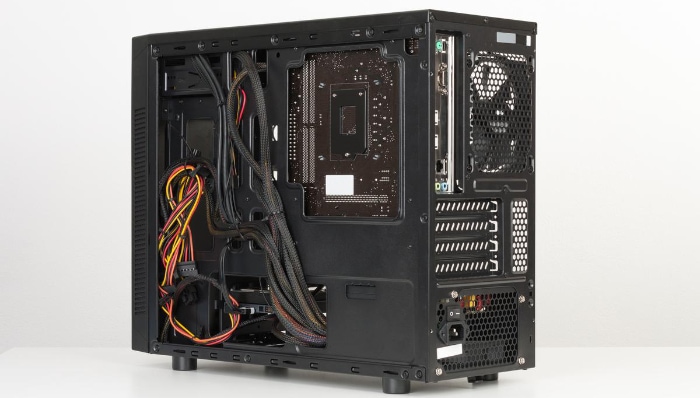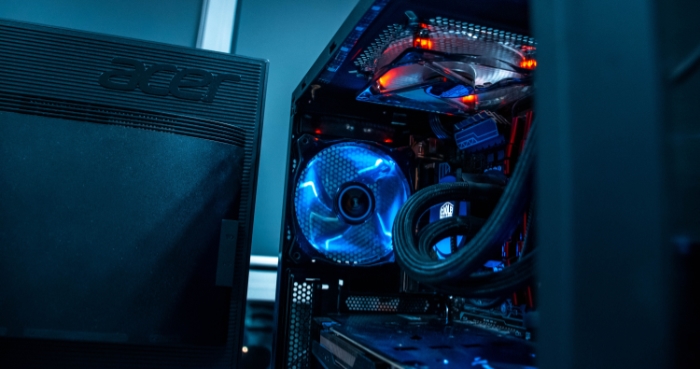Essential Types of Computer Cables: Enhancing Your Setup

Your computer is a marvel of interconnected components, each with its own distinct role in delivering performance, visuals, and usability. However, this technological symphony wouldn’t be possible without a behind-the-scenes maestro: computer cables.
They are the often-underestimated enablers of our digital experiences, joining together various hardware elements to form a seamless whole.
USB Cables
If you’ve ever connected a mouse to a laptop, transferred photos from your camera, or charged your smartphone using your computer, you’ve used a Universal Serial Bus or USB cable. This versatile cable standard is ubiquitous in modern computing, serving as a conduit for both data and power.
Types of USB Cables
USB cables come in various forms, each designed to meet specific needs. Among the most common are USB-A, USB-B, USB-C, Mini USB, and Micro USB.
- USB-A: A rectangular connector, commonly used on host controllers like computers and laptops.
- USB-B: Often found on devices like printers and external hard drives; designed for robust connections.
- USB-C: Known for its reversible plug orientation, it is increasingly becoming the standard for new devices.
- Mini USB: Predominantly used in older mobile devices and certain cameras.
- Micro USB: Commonly used for charging smartphones and connecting peripherals like Bluetooth speakers.
Functionality of USB Cables
One of the significant advantages of USB cables is their dual functionality: they can both transfer data and supply power. In the context of USB 3.0 and newer, data transfer speeds can reach up to 5 Gbps, whereas USB-C can go even higher. Power supply capabilities also vary, with some cables and adapters capable of delivering up to 100 watts of power.
Common Usage Scenarios
USB cables are a staple in a multitude of settings:
- Peripheral Connections: Connecting devices such as mice, keyboards, and printers to computers.
- Data Transfer: Transferring files between computers and storage devices like external hard drives and USB drives.
- Charging: Supplying power to smartphones, tablets, and other rechargeable devices.
HDMI Cables
When it comes to transferring high-definition audio and video between devices, High-Definition Multimedia Interface, better known as HDMI, is the go-to standard. Whether it’s for setting up a home theater system or ensuring that your computer display looks and sounds as good as possible, HDMI cables are indispensable.
Types of HDMI Cables
HDMI cables exist in various types to accommodate different technical requirements:
- Standard HDMI: Suitable for most home applications, capable of carrying up to 1080i or 720p video.
- High-Speed HDMI: Designed for resolutions up to 4K, including 3D and deep color.
- Premium High-Speed HDMI: Certified to reliably transmit 4K/UltraHD video with HDR, providing the best quality.
Technical Specifications of HDMI Cables
HDMI cables support the transmission of uncompressed video and can also handle compressed or uncompressed audio. Their capacity to carry both audio and video signals eliminates the need for separate cables, simplifying the setup and reducing clutter.
Common Usage Scenarios for HDMI Cables
HDMI cables find utility in a wide range of applications:
- Monitors and TVs: Connecting computers, gaming consoles, or other video devices to monitors and televisions.
- Projectors: Facilitating high-quality presentations in corporate settings or educational institutions.
- Audio Systems: Connecting soundbars or home theater systems to TVs or other audio components for an immersive audio-visual experience.
Ethernet Cables
Ethernet cables serve as the backbone of local area networks (LANs), ensuring robust and reliable data transmission between devices. Despite the proliferation of wireless technology, Ethernet remains the gold standard for speed and stability in network connections.
Types of Ethernet Cables
Various categories of Ethernet cables have been developed to cater to the evolving needs of network systems. Among the commonly used are Cat 5, Cat 5e, Cat 6, and Cat 7.
- Cat 5: Considered outdated, but still used in some legacy systems, capable of speeds up to 100 Mbps.
- Cat 5e: An enhanced version of Cat 5, supports speeds up to 1 Gbps and reduces crosstalk interference.
- Cat 6: Offers higher bandwidth compared to Cat 5e, and capable of supporting 10 Gbps for up to 55 meters.
- Cat 7: Features advanced shielding and is capable of supporting up to 10 Gbps over 100 meters.
Functionality of Ethernet Cables
Ethernet cables are primarily used for transferring data within wired networks. They are the workhorses that link computers, servers, and other hardware, enabling them to communicate with each other seamlessly.
They are especially preferred for applications that require high-speed data transfers and low latency.
Common Usage Scenarios
Ethernet cables come into play in various settings and for multiple purposes:
- Connecting Computers: To modems and routers for internet access.
- Networking Hardware: Linking switches, hubs, and routers in business or data center environments.
- Direct Connections: For fast data transfers between two computers without the need for network hardware.
DisplayPort Cables

When it comes to high-definition video transmission, DisplayPort cables stand out as a compelling alternative to HDMI. Specifically designed for computer displays, graphics cards, and professional IT equipment, DisplayPort cables offer exceptional performance and features.
Types of DisplayPort Cables
There are primarily two types of DisplayPort cables that you may encounter:
- Standard DisplayPort: The regular-sized version commonly used in desktop setups.
- Mini DisplayPort: A smaller alternative often found in laptops and some tablets.
Technical Specifications of DisplayPort Cables
DisplayPort cables are designed to support video resolutions of up to 8K and are compatible with High Dynamic Range (HDR) content. These features make them suitable for high-end graphics applications, professional video editing, and gaming setups where visual fidelity is paramount.
Common Usage Scenarios for DisplayPort Cables
Here’s where you’ll most likely need a DisplayPort cable:
- High-End Monitors: To ensure the highest resolution and color depth possible.
- Graphics Cards: Particularly those used in gaming rigs and workstations.
- Professional IT Equipment: Like servers and display consoles in data centers and production studios.
Audio Cables
Audio cables may not handle video or high-speed data, but they play a critical role in delivering high-quality sound to speakers, headphones, and other audio equipment. Understanding the different types of audio cables can help you create a more immersive and satisfying auditory experience in your computer setup.
Types of Audio Cables
Audio cables come in different configurations to serve a variety of audio requirements. The most common types are 3.5mm, 1/4-inch, XLR, and RCA.
- 3.5mm: Commonly used for headphones, computer speakers, and other portable audio devices.
- 1/4-inch: Typically used in professional audio setups, such as musical instruments and sound mixers.
- XLR: Used in professional audio applications, featuring a balanced signal that minimizes noise interference.
- RCA: Often used in home stereo systems and sometimes for connecting computer speakers.
Functionality of Audio Cables
The primary function of audio cables is to transmit audio signals between devices. They carry either analog or digital signals, depending on the type and specification of the cable and connected devices.
Common Usage Scenarios
Audio cables find a myriad of uses in a typical computer setup:
- Speakers: To deliver audio from a computer or audio interface.
- Microphones: For recording audio directly into a computer.
- Headphones: Connecting to a computer or audio interface for private listening.
SATA and PATA Cables
Serial ATA (SATA) and Parallel ATA (PATA) cables are vital for the internal workings of a computer, particularly for connecting storage devices to the motherboard. They have largely shaped the evolution of storage technology, from traditional hard disk drives to solid-state drives.
Functionality of SATA and PATA Cables
SATA and PATA cables are responsible for transferring data between the computer’s motherboard and its internal storage devices. While both serve similar functions, SATA is the newer technology and offers faster data transfer rates compared to PATA.
Types of SATA and PATA Cables
SATA cables are generally easier to identify and are commonly used in most modern computers. PATA cables are older and wider, with a ribbon-like appearance. They are becoming increasingly rare, as SATA’s advantages make it the preferred choice for most applications.
Common Usage Scenarios for SATA and PATA Cables
Here’s where these cables are most frequently employed:
- Hard Drives: Both SATA and PATA cables can connect traditional spinning hard drives to a computer’s motherboard.
- SSDs: Solid-state drives primarily use SATA connections for their higher speeds.
- Optical Drives: CD, DVD, and Blu-ray drives may use either SATA or PATA, depending on their age and specifications.
Conclusion
Selecting the appropriate cables for various applications within your computer setup is crucial for optimal performance. From USB cables that handle data transfer and power supply, to specialized options like HDMI and DisplayPort for high-definition video, each cable type serves a distinct purpose.
Ethernet cables remain irreplaceable for secure and speedy network connections, while audio cables are indispensable for a high-quality auditory experience. Internal data transfer, specifically for storage devices, relies on the capabilities of SATA and PATA cables.
Recognizing the importance of each cable type not only improves the efficiency of your system but also elevates your computing experience to new heights.



